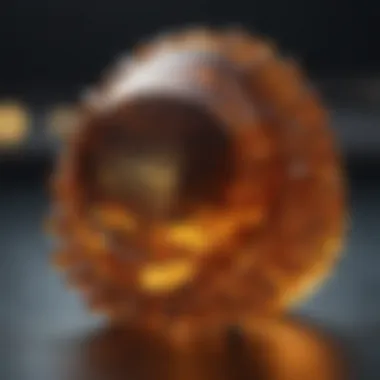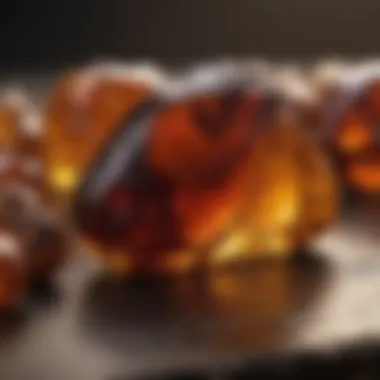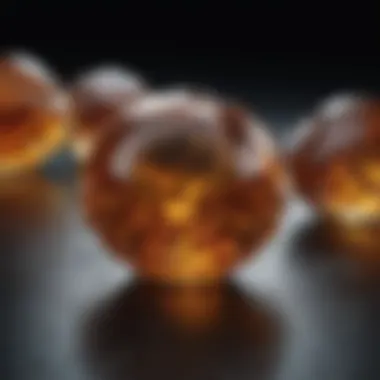Understanding Amber's Price: Factors and Trends in Value


Intro
Amber, with its golden hues and ancient origins, captivates both collectors and those sharing a passion for gemstones. Understanding how amber's price is shaped involves many elements, including its defining properties and wider market trends. This article delves into these aspects, providing valuable insights to help informed decisions regarding amber transactions.
Gemstone Overview
Definition and Origins
Amber is not a stone in the traditional sense. It is fossilized tree resin, rich in natural history. Its formation occurs over millions of years as trees exude resin that eventually hardens and undergoes a fascinating transformation. Amber is primarily found in regions like the Baltic Sea, the Dominican Republic, and Myanmar, contributing to its diverse characteristics and appeal.
Historical Significance
The history of amber is profoundly intertwined with human culture. Ancient civilizations revered amber, using it for talismans, jewelry, and decorative items. Its presence in burial sites from various epochs highlights its value across societies. Moreover, amber has been traded on routes such as the Amber Road, connecting the Baltic to the Mediterranean. The trade not only reflects amber's significance but also the economic and cultural exchanges throughout history.
Gemstone Properties
Hardness and Durability
Amber's hardness varies between 2 to 2.5 on the Mohs scale, making it relatively soft compared to many gemstones. This characteristic requires careful handling to avoid scratches or damage. However, its light weight and resistance to breaking make amber suitable for various forms of jewelry.
Color and Clarity
One of the most captivating aspects of amber is its color range. It can display warm yellows, rich oranges, and subtle browns, with clarity often dictating its value. The presence of inclusions, such as trapped insects or bubbles, adds unique character but can either enhance or diminish the price based on the collector's preference.
Amber's color, clarity, and authenticity are vital in determining its market value. Each piece tells a story, influenced by its origin and geological history. Collectors must pay attention to these factors when evaluating for purchase.
"Amber is not merely a gemstone; it is a witness to Earth's ancient past."
To navigate the complexities of amber pricing effectively, understanding these properties is essential. Each piece is unique, with each facet influencing its worth in the marketplace.
Preamble to Amber
Amber is more than just a beautiful stone; it has a rich history and cultural significance that transcends mere aesthetics. This introduction aims to lay the groundwork for understanding amber's unique characteristics and the factors influencing its price in the gemstone market. Focusing on multiple dimensions, we can appreciate why amber is valued by collectors, jewelry designers, and geology enthusiasts.
Amber is fossilized tree resin that has captured the imagination of people for centuries. It often contains inclusions, such as ancient insects, which adds to its value and allure. It is not just a gemstone but also a window into our planet's past. The importance of amber extends to its use in folk medicine, art, and even modern-day therapies, highlighting its versatility beyond jewelry.
When discussing amber, one must consider its appeal within various markets. The gemstone offers different price segments, influenced by quality, size, and unique features. Notably, certain colors and inclusions can yield higher prices than others. By exploring these qualities in detail, we provide a roadmap for buyers and collectors to make informed decisions.
Moreover, multiple factors govern the supply and demand dynamics of amber, which affect its market price. The knowledge of these elements equips collectors and enthusiasts with important insights, enabling them to navigate the market effectively. Fostering an understanding of these fundamental aspects allows for better purchasing decisions.
In summary, this introduction highlights the significance of amber as a gemstone and its inherent values. By delving into the interconnected elements surrounding its market price, the following sections will offer a comprehensive view, aiding readers in grasping the complexities of amber as both a collectible and an investment.
Amber: A Gemstone Overview
Amber holds a special place in the world of gemstones, serving not just as a piece of jewelry but as a window into history. It is fossilized tree resin, which means its origins trace back tens of millions of years. This long history imbues amber with a sense of mystery and allure. Collectors and enthusiasts are often drawn to its unique qualities—its color, texture, and inclusions that sometimes reveal ancient life forms.
Understanding amber as a gemstone involves grasping the diverse factors contributing to its value and significance. Unlike other gemstones formed through geological pressures, amber's formation process involves organic material, which results in varied colors. Most people know it for a warm yellow hue, but it can also appear in shades of green, blue, and even black.
The importance of amber extends beyond aesthetics. It has applications in holistic practices, with some believing in its healing properties. Additionally, the cultural significance of amber dates back to ancient civilizations; it was often used in talismans and jewelry, believed to provide protection.
As a jewel, amber appeals not only to those who appreciate its natural beauty but also to collectors of geological specimens. The trade segment around amber has also evolved, which means its pricing is influenced by various factors such as market demand, authenticity, and regional distribution.
Amber, therefore, is not merely a gemstone. It is a testament to ancient ecosystems, a piece of art, and potentially a wise investment for collectors. Understanding its characteristics elaborates on what drives its desirability in the market.
The Physical Characteristics of Amber
The physical characteristics of amber play a crucial role in determining its value in the gemstone market. Understanding these characteristics can help buyers make informed decisions when purchasing amber. This section details various aspects like color variations, clarity, and inclusions that not only affect the aesthetics of amber but also its pricing. By grasping how these elements interact, collectors and enthusiasts can appreciate amber beyond its beauty, considering factors that influence its economic worth.


Color Variations
Amber exhibits a remarkable array of colors, ranging from golden yellows to deep oranges and even shades of green and blue. Each color variation is unique and can significantly influence the price of the amber piece. For instance, deep cognac amber generally commands a higher price compared to lighter, more common hues due to its rarity and rich appearance.
The presence of color zones can also be a factor. Some pieces may showcase gradients or mixed colors, which adds to their visual appeal and can elevate their market value. Notably, rare colors, such as blue or green amber, can skyrocket in price because they are scarce. The fascination with these hues often draws collectors and designers, contributing to their high demand.
Clarity and Transparency
Clarity and transparency are critical considerations in evaluating amber. Amber can range from perfectly clear to opaque, and clarity directly impacts desirability. Clear amber allows for a more direct view of any inclusions, fossils, or unique features within. High clarity often signifies high quality, making such pieces more valuable.
Conversely, translucency and opacity can create a charm of their own. Some buyers appreciate the richness that comes with slightly murky pieces, so there's a subjective element to this aspect. The transparency of a given amber piece also plays into how it captures light, adding depth and richness to its appearance.
Inclusions and Fossils
Inclusions and fossils found within amber are among its most captivating features. They provide insight into the ancient ecosystems from which the amber originated. Many collectors seek out pieces with significant inclusions, such as insects or plants preserved in the resin. The type and rarity of these inclusions can dramatically affect price.
Pieces containing well-preserved fossils are often seen as both beautiful and scientifically interesting, drawing a diverse audience. The more unique and distinct the inclusion, the higher the potential value. Each piece tells a story of ages past, merging geology with art and history, which appeals to both gem collectors and naturalists alike.
Understanding the physical characteristics of amber is essential for anyone interested in its pricing, as they directly influence desirability and market value.
Factors Influencing Amber Price
Understanding the factors that influence amber prices is crucial for anyone involved in the acquisition and valuation of this gemstone. Amber prices fluctuate based on various elements, including market dynamics, quality, and rarity. Recognizing these factors can lead to informed purchasing decisions, ultimately protecting investments and ensuring fair transactions.
Supply and Demand Dynamics
The interplay between supply and demand is vital in any market, and amber is no exception. The availability of amber is affected by geographic sources and extraction practices. Notably, countries like Lithuania, Poland, and the Dominican Republic are prominent suppliers of amber. When the supply from these regions diminishes due to natural limits, the price tends to rise, reflecting the scarcity.
Conversely, when large quantities are found or produced, prices may decrease, leading to a fluctuating market. For example, an influx of lower-quality amber can saturate the market, driving prices down. Thus, potential buyers should keenly watch the global production trends to anticipate pricing changes.
Quality of Amber
Quality is one of the most direct determinants of amber’s price. Factors such as clarity, color richness, and the presence of inclusions play significant roles. Higher quality amber, exhibiting vivid colors and minimal inclusions, tends to command higher prices. Conversely, darker or murkier specimens are generally priced lower.
Moreover, clarity is paramount. Amber that is transparent and free of cracks or clouding is significantly more desirable. Buyers should assess the characteristics of amber carefully; they should not just consider surface appearance but also internal features. Proper assessments can significantly affect investment outcomes.
Rarity of Color and Inclusions
Amber comes in various colors, including yellow, red, green, and even blue. The rarity of a specific color directly affects its market value. For instance, blue amber is significantly rarer than traditional yellow amber, leading to higher price points. Collectors often seek out unique colors, pushing prices upward for those exceptional finds.
Inclusions, such as ancient plant or insect life, further enhance the value of amber. Specimens containing well-preserved inclusions provide a glimpse into the past and exhibit a unique characteristic that can captivate buyers. Some collectors might pay a premium for amber with notable inclusions that tell a story or hold historical significance.
In summary, the price of amber is molded by supply and demand dynamics, inferiority or superiority of quality, and the rarity of its many colors and inclusions. Having a firm grasp of these elements will enable buyers to navigate the complex amber market with confidence.
Market Trends Affecting Amber Prices
Understanding the market trends that influence amber prices is crucial for anyone looking to purchase or invest in this gemstone. The fluctuations in pricing are not random; they are shaped by various economic indicators, consumer behavior, and industry changes. By examining these trends, collectors and buyers can make informed decisions that align with market movements and their own financial objectives.
Recent Pricing Trends
In recent years, the price of amber has shown considerable variation. Several factors contribute to this dynamic landscape. First, the rise of online platforms for buying and selling has expanded marketplace accessibility. This increased access allows more buyers to enter the market, often pushing prices up for desirable pieces. Additionally, economic factors such as inflation can also affect the pricing of amber, making it a more attractive option for investment as inflation erodes traditional currency value.
Moreover, investing in unique amber varieties, such as blue amber from the Dominican Republic or the Baltic amber known for its rich history, has become popular. As demand rises, so do prices. The appreciation for amber's aesthetic and historic value is increasingly recognized, leading to higher valuation rates. Various international gem shows also influence prices by highlighting quality pieces, resulting in auction spikes.
Collectibles and Investments
Amber is not only valued for its beauty but also as a collectible item. Investors are increasingly recognizing amber as a commodity that can diversify their portfolio. The rarity of certain types of amber, especially those with unique inclusions, can lead to significant returns. Collectors often seek out these distinct varieties for both personal enjoyment and potential financial gain.


Market sentiment plays a vital role in driving investment in amber. When there is a perceived value in certain qualities, such as clarity or unique fossil inclusions, collectors are willing to pay a premium. This trend has encouraged a more speculative approach within the amber market, where buyers are attentive to emerging trends that can drive pricing higher.
"Proper assessment of the amber market trends can reveal hidden gems worth investing in."
As investors look to capitalize on their purchases, knowing how market trends shape pricing is essential. Understanding these nuances helps in identifying opportunities and realizing the true value of amber in the broader gemstone market.
Regional Variations in Amber Pricing
Understanding the regional variations in amber pricing is critical for buyers and collectors alike. Different markets can have significant fluctuations in amber prices influenced by local demand, cultural significance, and availability. By grasping these elements, collectors can make more informed decisions and understand the intrinsic value of the amber they seek.
European Market Insights
Europe has long been considered a center for amber trade, especially the Baltic region. In countries such as Poland, Lithuania, and Russia, amber is deeply embedded in culture and history, which impacts its pricing. The Baltic amber is often favored for its higher quality and unique characteristics.
Local factors play a key role in shaping these prices. For instance, economic conditions, tourism, and traditions surrounding amber jewelry can create demand spikes. During the tourist season, prices may increase as many visitors seek authentic local craftsmanship.
Moreover, the European market is known for its stringent standards regarding quality and authenticity. Certification agencies like the International Association of Jewelry Professionals play a pivotal role here. Consumers often pay a premium for amber that comes with documentation proving its authenticity. This factor can lead to marked differences in pricing across regions.
Key considerations in the European market include:
- Cultural significance: In some regions, amber is a symbol of wealth, thus driving prices higher.
- Quality control: Strict regulations help maintain a high standard, affecting availability and pricing.
- Tourist trends: Shifts in travel patterns can lead to varying demand.
Asian Market Dynamics
The Asian market, particularly in countries like China and Japan, has seen a burgeoning interest in amber, yet the dynamics differ considerably from Europe. In China, amber has been associated with traditional beliefs and is often seen as a status symbol, further increasing its allure among collectors and investors.
In recent years, the demand from Asia has prompted market shifts. Prices have surged as collectors seek rare color variants and specific types of amber. The interest is sometimes fueled by speculative trends, where buyers anticipate future value increases, driving prices even higher.
However, the market is not without complexity. Counterfeit products may flood the market, leading to challenges in determining genuine amber. This underscores the importance of verifying authenticity, as many buyers rely on online marketplaces, which may not always ensure quality.
Essential insights into the Asian market include:
- Cultural trends: Collecting amber is often tied to traditions and social status, affecting its market value.
- Authenticity concerns: Buyers must be vigilant with verification to avoid counterfeits.
- Speculative buying: The potential for future profits attracts a diverse group of investors, impacting current prices.
Understanding these regional differences not only informs buyers of potential costs but also enriches their appreciation for the rich history and cultural significance of amber across the globe.
Authenticity and Price Assessment
In the gemstone market, ensuring the authenticity of amber is fundamental to determining its price. Genuine amber holds significant value, not just for its aesthetic appeal, but also for its geological history and rarity. If one purchases or collects amber, understanding how to assess its authenticity can mean the difference between an investment and a loss.
Identifying Genuine Amber
Identifying genuine amber requires knowledge of its physical properties and characteristics. Many people may mistake synthetic or treated amber for natural amber. Effective identification hinges on several key factors:
- Color: Natural amber comes in various shades, including yellow, orange, and green. Some may exhibit inclusions, which can often serve as identifying markers.
- Temperature: Genuine amber tends to feel warm to the touch, while plastic replicas may feel cooler. This difference in temperature is due to the material's natural properties.
- Ultraviolet Light Test: Under ultraviolet light, natural amber glows dimly, whereas some synthetic materials do not react.
Many enthusiasts utilize these characteristics to differentiate real amber from imitations. However, the process can be nuanced and may require experience.
Tools for Verification
Various tools can aid in the verification of amber’s authenticity. Some of the most commonly used tools include:
- Refractometer: This instrument measures the refractive index of the amber. Real amber typically has a refractive index between 1.54 and 1.55.
- Polariscope: A polariscope can help to detect any optical phenomena, giving insights into the internal structure of the amber.
- Microscope: A jeweler’s microscope allows for detailed viewing of any inclusions or clarity issues, which can signify whether the amber is natural.
- Density Test: By measuring the weight of the sample and comparing it to its size, one can estimate the density, which should typically range around 1.05 to 1.1 grams per cubic centimeter.
"Being informed about authenticity not only protects your investment but enhances your appreciation of amber's natural beauty."
The Role of Certification


Certification plays a critical role in the amber market, particularly in establishing trust and authenticity among collectors and buyers. As demand for amber increases, so does the likelihood of counterfeit products entering the market. Therefore, certification serves not only as proof of authenticity but also as a standard for quality assurance. Without such verification, consumers may struggle to distinguish between genuine amber and synthetic or imitative materials. This situation creates a need for reliable agencies to assess and validate amber specimens.
Importance of Certification Agencies
Certification agencies are responsible for evaluating and verifying the quality of amber. These organizations employ experts who have in-depth knowledge of various amber types and their unique characteristics. The importance of these agencies cannot be overstated. Through their assessments, buyers gain the confidence needed to make informed purchasing decisions. Individuals may seek products from recognized agencies like the International Gemological Institute or similar organizations renowned for their scrutiny and expertise.
- Protection Against Fraud: Certification provides a safeguard against fraudulent practices, which are more prevalent in high-demand markets.
- Market Credibility: Reputable agencies enhance the overall credibility of the amber market by promoting transparency and integrity.
- Increased Consumer Confidence: Buyers who possess certified amber can feel secure in their acquisition, knowing it has been assessed by trained professionals.
In many ways, the certification process directly contributes to the longevity of the amber market itself. If buyers trust the authenticity of the products they purchase, the market stands to flourish.
How Certification Affects Price
The certification of amber not only determines authenticity but also significantly influences its price. Certified amber can command higher prices compared to uncertified pieces. This price difference stems from several factors:
- Brand Trust: Items certified by recognized authorities like the Gemological Institute of America are often valued more highly due to their credibility.
- Market Perception: Certified pieces are seen as more desirable, leading to higher demand and ultimately raising their market value.
- Quality Assurances: Certification often includes a detailed report outlining the amber's characteristics, such as color and clarity, providing additional information that can justify a higher price.
A piece of amber with certification generally retains its value better than an uncertified equivalent.
In summary, the role of certification is vital not only to ensure the integrity of transactions in the amber market but also to enhance perceived value among enthusiasts and collectors. The combination of verified quality and authenticity supports maintaining a healthy economic ecosystem surrounding amber.
Future Predictions for Amber Pricing
Understanding the future of amber pricing is essential for those involved in the gemstone market. As with any commodity, prices do not remain static; they fluctuate based on various factors. Anticipating these shifts can help buyers and sellers make informed decisions. This section will explore the market outlook and potential technological impacts that could influence the value of amber in the coming years.
Market Outlook and Projections
The amber market has shown resilience and adaptability over the years. Recent studies suggest a steady increase in the global demand for amber, particularly in Asia and Europe. This interest can be attributed to several factors such as increasing consumer awareness of amber's unique qualities and its historical significance.
Trends indicate that the value of amber may continue to rise as collectors seek pieces with unique characteristics. In addition, the popularity of amber jewelry among younger consumers is likely to drive demand further. Key indicators that buyers should monitor include:
- Cultural trends: Shifts in aesthetic preferences can influence demand.
- Economic factors: Changes in disposable income levels can affect purchasing behavior.
- Environmental considerations: As more consumers become eco-conscious, sustainable sourcing will play a role in pricing.
Evaluating these elements can give insights into potential price movements.
Technological Impact on Market Value
Technology has the potential to revolutionize the amber trade. Innovations in extraction processes, verification tools, and digital marketing strategies can all impact pricing.
For instance, the rise of online marketplaces has transformed how consumers access amber. These platforms provide global visibility for sellers, allowing them to reach a wider audience. Furthermore, advancements in gemological tools enable buyers to authenticate and assess the quality of amber more accurately.
Key technological developments to watch include:
- Digital verification systems: These can help reduce the sale of counterfeit ambers.
- Online retailing trends: E-commerce clearly shapes consumer purchasing habits.
- Manufacturing advancements: New techniques may affect the supply side, influencing market prices.
Overall, technology will likely play a pivotal role in shaping the future landscape of amber pricing, making it crucial for stakeholders to stay updated on these trends.
"The interplay between market conditions and technology will determine where amber pricing heads in the next decade."
By understanding both the market outlook and the potential technological impact, collectors, jewelers, and investors can better navigate the amber market with confidence.
Epilogue
The conclusion of this article encapsulates the various dimensions influencing the pricing of amber. It is essential to understand that the market for amber is shaped by several interrelated elements that require careful consideration.
First, the inherent characteristics of amber, such as its color variations, clarity, and the presence of fossils or inclusions, all significantly affect its market value. For collectors and investors, recognizing these qualities can aid in making informed decisions about purchasing and valuing amber.
Moreover, the dynamics of supply and demand are crucial. As interest in amber persists, fluctuations in availability can lead to price changes. Buyers should be aware of these market conditions, which can fluctuate based on geopolitical factors and mining practices.
The role of certification also cannot be neglected. Authenticity verification through recognized organizations reassures buyers about the quality and origin of the amber. This added layer of scrutiny often translates to a higher value in the marketplace. Buyers need to seek out reliable certification to avoid potential pitfalls.
In summary, understanding amber prices involves a multi-faceted analysis of not only the physical properties of amber but also market trends, authenticity, and certification. Each of these factors plays a part in shaping the overall value that consumers encounter, offering insight into a complex and evolving market. Collectors and enthusiasts alike benefit from a thorough comprehension of these elements, which can enhance their purchasing strategy in a continually changing gemstone landscape.
"Knowledge of the characteristics and trends affecting amber pricing enhances confidence in purchasing decisions."
Embracing this knowledge allows gem enthusiasts to navigate the amber market with greater assurance, ensuring choices that are both financially sound and personally satisfying.



